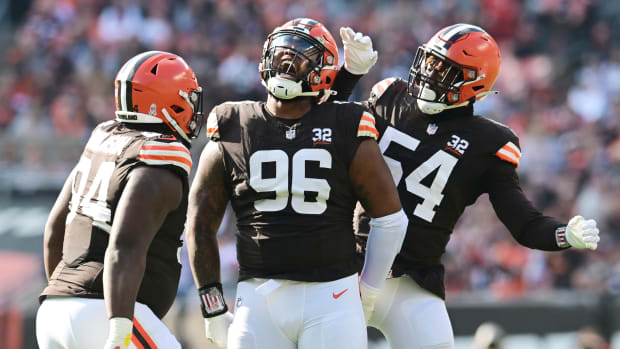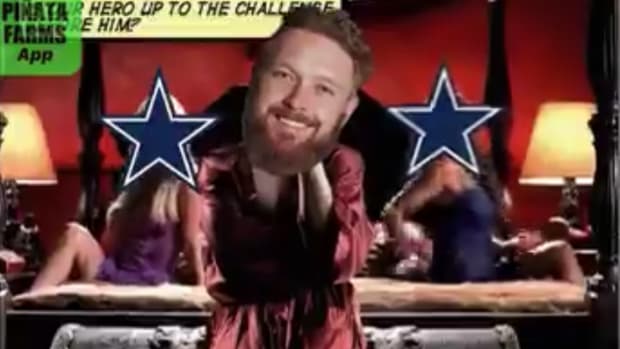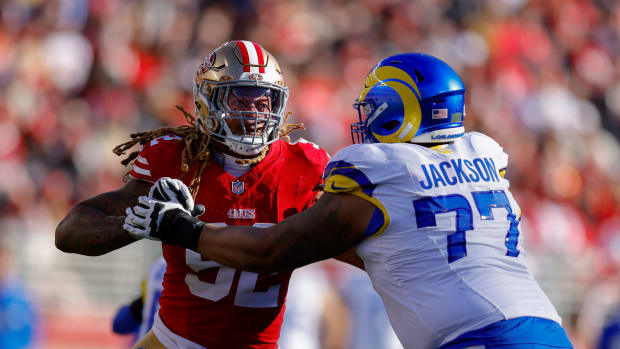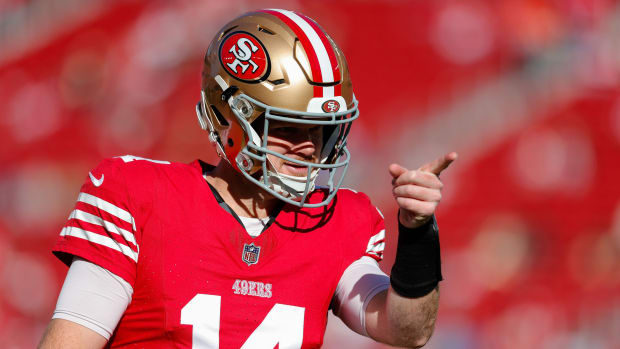Lessons Learned at the Draft
Seven days after the start of the draft, it’s time to go through all seven rounds and find seven lessons.
Round 1, Pick 3
San Diego Chargers: Joey Bosa, DE, Ohio State
The Lesson: NFL teams can keep a secret.
An hour before the NFL draft I got a text from a trusted source saying he believed the Chargers would select Bosa with the third overall pick. I was in Los Angeles, covering the Rams’ draft party at the L.A. Live complex.
Up until the moment Bosa was drafted, the media projections for the third pick had been a sweeping failure in prognostication akin to the yearlong onslaught of political op-eds declaring Donald Trump had no shot at the nomination.

The Chargers kept under wraps their love of Joey Bosa before selecting him third overall in the draft.
Jon Durr/Getty Images
ESPN’s Mel Kiper sent DeForest Buckner to the Chargers; Todd McShay gave them Ronnie Stanley; I sent Laremy Tunsil to San Diego.
But now I had somebody in the know telling me that a player who had hardly been mocked to San Diego, who didn’t seem to fit any glaring deficiency on the roster, was not only going to be the pick, but had been targeted by the Chargers for months. Eventually, I tweeted the news about five minutes before the pick, which, I admit, is about as pointless as CNN and Fox News racing to be the first to declare Virginia on election night. But I was first, so there.
What bothered me was the completely successful bid to keep the pick secret up until moments before the draft. What was the point? Once the Rams had traded for the first overall pick to draft a QB, and the Eagles traded for the second pick to draft a QB, why would it matter to San Diego to keep its Bosa love a secret? The answer was a potential trade that would’ve blown up the first round.
The only reason to play your cards so close to the vest if you’re GM Tom Telesco is in the interest of convincing another team they’d need to trade up in order to get their guy. If you’re San Diego, and teams know you want Bosa, your pick loses value. Obviously, the Chargers didn’t hear any offers good enough to risk losing out on a player they’d been comfortable drafting for months, and they went ahead and turned in the pick. Regardless, the draft-day surprise is educational in one important sense: NFL teams, for the most part, can keep a secret. If you read anything about a team “loving” a certain prospect, it’s either deliberate or speculative.
* * *
Round 2, Pick 51
New York Jets: Christian Hackenberg, QB, Penn State
The Lesson: Recency bias is non-applicable to NFL teams.
Watching Hackenberg go off the board made me think of a conversation I had with the Penn State quarterback’s father during the school’s March 17 pro day. For three months I’ve been working on a story about the experiences and circumstances that define quarterbacks, and of all the anecdotes I’d heard from high school coaches and parents of the dozen or so QBs in the class, this was my favorite:
Hackenberg was a rising high school senior, having committed after his junior season to PSU and coach Bill O’Brien, when the NCAA handed down a four-year bowl ban and a $60 million fine as a result of the school’s handling of serial child predator and ex-coach Jerry Sandusky. Given the option to back out of his commitment, Hackenberg declined.
• MONDAY MORNING QB: Peter King goes inside the Dallas draft room
“When he decided what to do,” Erick Hackenberg said, “he stood there and he had the tears coming down in his eyes and he goes, ‘Dad, we’re gonna make this work.’ That was a moment for me as a dad that I realized we did it the right way.”
Hackenberg’s pre-draft interviews earned conflicting reviews as relayed to myself and my colleague, Jenny Vrentas, pertaining to his handling of the James Franklin question. (Hackenberg’s performance declined under Franklin following O’Brien’s departure). Whether or not the Jets felt he handled the query appropriately, they only needed to dig a few years into his well-documented athletic career to understand that Hackenberg is the kind of guy who will stay the course in the face of the sort of adversity he’ll encounter with a budding quarterback controversy in the No. 1 media market. Obviously, teams aren’t nearly as susceptible to recency bias as we are.
* * *

New Patriot Jacoby Brissett probably won’t get to wear his college number when he suits up for New England.
Don Juan Moore/Getty Images
Round 3, Pick 91
New England Patriots: Jacoby Brissett, QB, N.C. State
The Lesson: Draft quarterbacks cannot be ranked.
Most teams pegged Brissett as a late Day 3 prospect. One team I spoke with had him as the 10th passer on the board. But the Patriots are preparing for the possibility that Tom Brady will outlast backup Jimmy Garoppolo’s rookie contract (which expires after the 2017 season), and they saw something in Brissett that few other teams did.
He’s got a big arm and a demonstrated capacity for the mastery of new offenses—after transferring to N.C. State, he earned the starting job in his first season of eligibility in 2014 and produced 26 touchdowns with five interceptions. He earned glowing reviews from both Charlie Weis, his offensive coordinator for one year, and Bill Parcells, who watched Brissett play in high school at Dwyer in Palm Beach Gardens, Fla. Weis and Parcells each have Patriots ties, so references could have played a role. Hue Jackson, who coached at USC for four seasons before taking his first NFL job in 2001, drafted USC quarterback Cody Kessler in the third round, about three rounds before he was expected to go. Intangibles weigh heaviest at the quarterback position, and many coaches lean on trusted sources when investigating traits like leadership and learning ability. It’s a sliding scale, based on relationships and personalities rather than concrete, measurable ability. It’s one of the main reasons quarterbacks cannot be ranked.
That could explain the Brissett pick—or maybe the anti-establishment, contrarian side of Belichick simply found a kindred spirit in the 23-year-old.
A story from Brisset’s high school coach, Jack Daniels: “He wasn’t really ranked by these recruiting services, and he didn’t go to any college camps. Coaches would come out and watch [high school teammates] Matt Elam or Nick O’Leary and say, ‘Who’s the quarterback?’ Urban Meyer came down and saw Jacoby and saw his size, and he came in the gym and offered Jacoby a “grayshirt,” where you pay your own way for your freshman year. So Jacoby’s like, What the hell is that? Get that s--- out of here. He has a lot of pride.”
* * *
Round 4, Pick 110
Los Angeles Rams: Tyler Higbee, TE, Western Kentucky
The Lesson: NFL teams dig deep to find tight ends.
As part of a pro day swing through southern states, I stopped by Western Kentucky on March 29. Reps from 30 teams showed up to watch the eligible Hilltoppers work out. As is often the case, few were there to see the most recognizable name—one-time Heisman candidate quarterback Brandon Doughty. Instead, the main draw was Higbee, the 6-6, 250-pound tight end who missed seven games with a late-season knee sprain. The big man displayed soft hands, fluid hips and impressive speed given he was only four months removed from left knee surgery.
I asked one of the tight end coaches in attendance what he thought was special about Higbee. His response: “The athleticism. That’s all you really have to go on with a lot of tight ends these days, because college teams don’t use them the way we do. With tight ends, it’s a big projection.”
It’s a fair point, and one often overlooked; teams are reaching deeper and deeper into the college football ranks to find tight ends worthy of cultivation. Take a look at the list of schools producing tight ends drafted in Rounds 4-7 in 2016:
Western Kentucky
South Carolina State
South Carolina
Princeton
UTSA
Baylor
UCLA
Montana State
That’s three Power 5 conference teams out of eight prospects. The Baylor tight end, Rico Gathers, is a college power forward who hasn’t played football since middle school. And the UCLA “tight end,” Thomas Duarte, weighed 225 pounds in college and played wide receiver. Ten years ago, in the 2006 draft, there was just one tight end selected out of a non-Power 5 school. Lately, there isn’t another position in the NFL so reliant on small-school and/or inexperienced prospects.
The tight end coach I talked to guessed Higbee would probably be a fourth-round or fifth-round pick, and that guess came less than 12 days before Higbee was arrested outside a Bowling Green, Ky., bar for punching a man unconscious at 2 in the morning.
The Rams drafted him in the fourth.
* * *
Round 5, Pick 174
San Francisco 49ers: Fahn Cooper, OT, Ole Miss
The Lesson: The best available player sometimes isn’t worth the hassle.
Maybe you watched the Ole Miss pro day on NFL Network, or maybe you missed it because you have a life. I was there for the spectacle of Hugh Freeze’s first recruiting class taking its last steps in the Manning Center, and there was one sight that stood above the rest: Laremy Tunsil, doing things few 310-pound men should be able to do. His performance in blocking drills without pads was amplified by his comparatively slow-footed teammates who waddled and jiggled their way through crude reenactments of each feat Tunsil performed. They seemed to be there for the sole purpose of making Tunsil look better. “Watching him is like watching football porn,” said one NFL offensive line coach days later.
It was a true holy crap moment like I’ve never seen at a pro day, followed up a month later by an even wilder draft day which saw Tunsil’s social media accounts hacked by an unknown saboteur. Tunsil’s drug use, rumored even before teammate Robert Nkemdiche told members of the media that Tunsil was in the room with him the night he fell out a hotel window, was now bare to the world in the form of a video of the lineman hitting a gas-mask bong. The Dolphins eventually took the man who had been described as the best offensive player in the draft with the 13th pick.
Four rounds later, the 49ers selected one of those extras in the Tunsil pro day performance from a month ago. Cooper filled in admirably for Tunsil while the latter was serving a suspension during his third and final season, for receiving improper benefits. Cooper, a former Bowling Green recruit who spent a year in community college before landing at Ole Miss, didn’t notice Tunsil slide: “I wasn't watching the draft at all,” he told SB Nation. “I was at Cheesecake Factory.”
The 49ers had the opportunity to fill a big need and draft Tunsil at No. 7, but passed and ultimately took two tackles—Cooper and Georgia’s John Theus. Sometimes the best player available just isn’t worth the hassle.
* * *
Round 6, Pick 180
Minnesota Vikings: Moritz Böhringer, WR, Schwäbisch Hall Unicorns
The Lesson: The NFL marketing machine cannot be beat.
For my money, the best moment of draft day came in the second-to-last round when Böhringer heard his name called by the Vikings. (My MMQB colleague Jenny Vrentas wrote about him here.) A veteran of Germany’s highest level of football (which seems to be comparable to Division III competition in the States), Böhringer was drafted before receivers from Texas Tech, TCU and Ole Miss, to name a few.
The best part?
The NFL invited Böhringer, his mother and his sister to Chicago to take in the draft and be interviewed on the NFL Network set should he get selected. And wouldn’t you know it, the Vikings made the call and a sheepish 22-year-old still learning English assumed the spotlight. Böhringer, who learned the game watching Adrian Peterson highlights on YouTube, was asked how it felt to join the team that ignited his love of football. “The coolest thing ever,” he answered. He shot from 1,500 Twitter followers to 19,400 in days, and the NFL Network’s draft coverage, once again, trumped the NHL playoffs by a wide margin.
The NFL marketing machine cannot be beat.
* * *
Round 7, Pick 223
Miami Dolphins: Brandon Doughty, QB, Western Kentucky
The Lesson: The 7-on-7 generation has arrived.
Remember Doughty, mentioned above as the undercard at the Hilltopper pro day? I also talked to his father, Howard, for my QB story. Brandon Doughty, who hails from Davie, Fla., grew up in the land of watered-down spread offenses with athletic quarterbacks, most of whom amounted to glorified running backs. So Howard took Brandon to tryouts for the South Florida Express, a 7-on-7 team founded by Brett Goetz in 2007. Brandon would brush shoulders with Geno Smith and Teddy Bridgewater.
“It was a big deal for him,” said Howard Doughty. “I believe it really helped.”
In 2013 the South Florida Express program helped produce two draft picks, including Smith. In 2014 there were three, including Bridgewater and fellow first-round pick Ryan Shazier. In 2015 there were three more, including first-rounder Amari Cooper. And in 2016 there were five SFE alums, including first-round pick Artie Burns.
It’s a safe bet The MMQB will be headed to SFE tryouts this winter to get a head start on our 2021 mock drafts.
• Question or comment? Email us at talkback@themmqb.com.





































